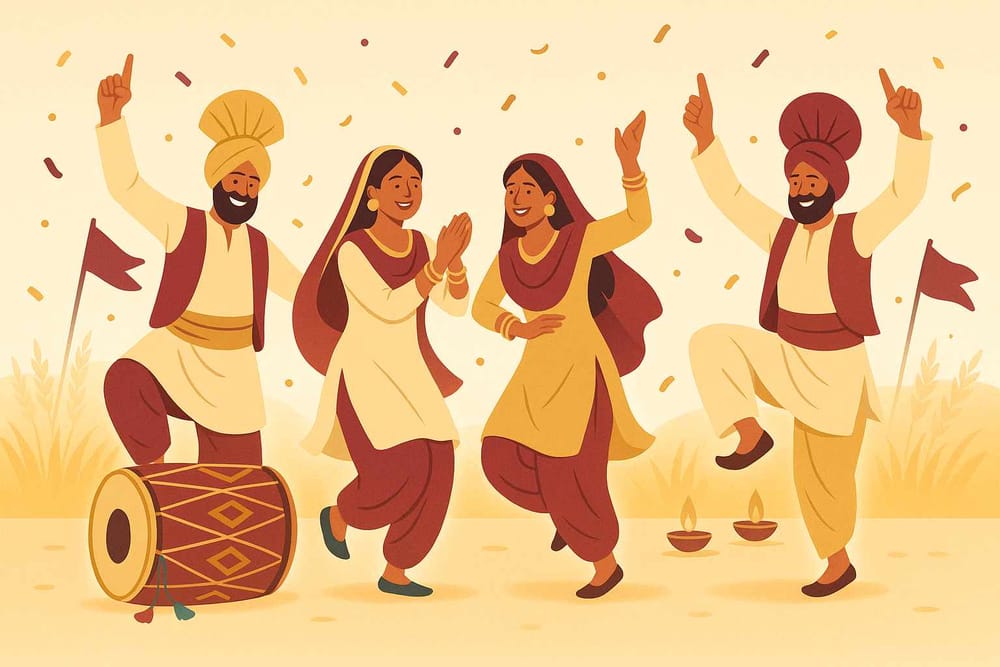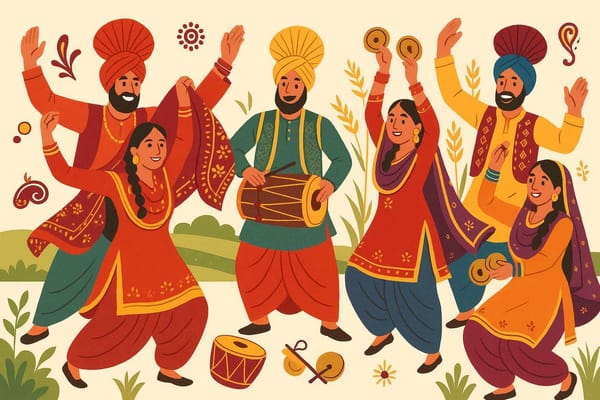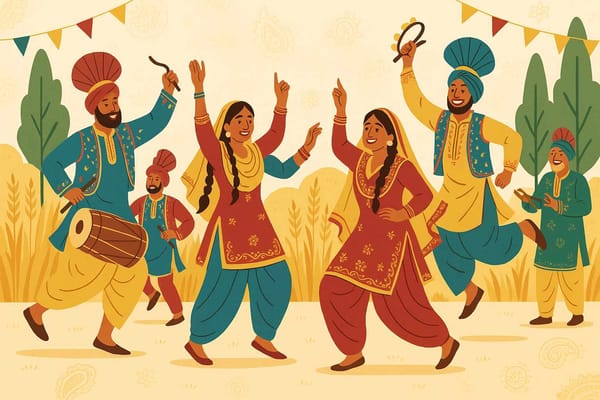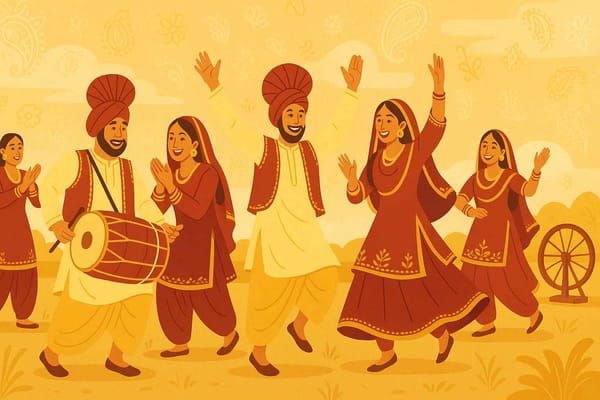
Exploring Vibrant Folk Dances of Punjab- A 2025 Guide
Have you ever felt the earth tremble with the beat of a dhol? Have you seen a whirlwind of colours so bright it makes your heart sing? If you have, you’ve likely witnessed the magic of Punjabi folk dance. It’s more than just movement; it’s the sound of joy, the story of the soil, and the very heartbeat of Punjab. This isn't just about performance; it's a feeling, an energy that flows from the heart of its people straight into their dancing feet.
These dances are a beautiful window into the soul of Punjab, a land rich with history and spirit. They tell tales of hard work in the fields, the joy of a good harvest, the romance of folk legends, and the deep-rooted faith that sustains the community. So, come, let's take a walk through the mustard fields and vibrant villages of Punjab and feel the rhythm of its most cherished traditions.
From the Fields to the World Stage: The Roots of Punjabi Dance
The story of Punjabi folk dances begins in the lap of mother earth. Imagine farmers, after months of toil, seeing their fields lush with golden wheat. Their happiness couldn't be contained in mere words, so it burst forth in song and dance. This is the very essence of these traditions—they are born from raw, unfiltered emotion.
The powerful beat of the dhol, the sweet melody of the algoza (a double flute), and the sharp clang of the chimta aren't just musical notes; they are echoes of a life lived in harmony with nature. While men’s dances often showcased strength and vigour, women’s performances were a graceful canvas for their stories, dreams, and daily lives. Many of these art forms also carry subtle spiritual threads, weaving in elements of Sikh and Sufi wisdom, making them a beautiful blend of celebration and devotion. This incredible connection is a testament to how folk music and dance define culture, carrying heritage forward with every beat.
Bhangra: The Roaring Celebration of Life
When you think of Punjabi dance, the first image that probably comes to mind is Bhangra. And for good reason! Bhangra is not just a dance; it’s an explosion of pure, unadulterated joy. Born as a way for farmers to celebrate the harvest festival of Vaisakhi, its energetic steps mimic farming activities like ploughing the fields, sowing seeds, and reaping the harvest. The dhol player stands at the center, not just as a musician, but as the soul of the performance, his beats dictating the rhythm and energy of the dancers.
Dancers clad in vibrant kurtas, flowing lungis (or chadras), and proudly tied turbans are a sight to behold. But Bhangra is no longer confined to the villages of Punjab. It has taken the world by storm, its infectious energy fusing with global music genres like hip-hop and reggae. From Bollywood blockbusters to wedding parties across the globe, Bhangra continues to be a powerful symbol of Punjabi pride and celebration.
Giddha: The Graceful Heartbeat of Punjabi Women
If Bhangra is the thunder, then Giddha is the beautiful, rhythmic rain that follows. Performed by women, Giddha is a dance of grace, elegance, and powerful storytelling. It is considered the female counterpart to Bhangra, but it has a unique charm of its own. Women form a circle, and through rhythmic clapping and singing of folk couplets called boliyan, they share everything—from playful banter about their in-laws to tales of love and daily life.
The movements are fluid and captivating, with intricate hand gestures and footwork that mesmerize the audience. The colourful salwar kameez, shimmering phulkari dupattas, and long, braided parandis add to the visual poetry of the performance. Giddha is a staple at weddings, Teej, and other festive occasions, becoming a space for women to bond, celebrate their womanhood, and express themselves freely.
Diving Deeper: More Folk Gems from Punjab's Treasure Trove
While Bhangra and Giddha are the most famous, Punjab’s cultural landscape is dotted with many other beautiful dance forms. Each tells a unique story and adds a different flavour to the region's rich artistic heritage.
Jhumar: The Dance of Ecstasy
- Originating from the Sandalbar region, Jhumar is a slower, more graceful, and rhythmic dance compared to Bhangra. Its name comes from 'jhum,' which means to sway, and that’s exactly what the dancers do.
- It is often performed in a circle on moonlit nights and at weddings, with dancers moving in a gentle, swaying motion. The movements are incredibly elegant, focusing on graceful hand and footwork that creates a truly hypnotic effect.
Sammi: A Tale of Tribal Tradition
- Sammi is another beautiful dance performed by women, hailing from the tribal belts of Punjab. It tells the story of a girl named Sammi and her love, expressing themes of longing and separation through its gentle, flowing movements.
- The dance is characterized by its unique and intricate hand gestures and is performed in a circle, with the dancers swaying gracefully from side to side. It’s a soulful performance that connects the audience to the ancient folklore of the land.
Luddi: The Dance of Victory
- Luddi is a dance of celebration, traditionally performed by men to mark a victory, whether in a battle or a sporting event. It’s a moment of pure triumph expressed through energetic, snake-like movements.
- Dancers often place one hand behind their back and the other in front of their face, swaying their heads and bodies in unison. It’s a joyous and infectious dance performed in circles, with performers clicking their fingers and clapping to the beat.
Malwai Giddha: The Rhythmic Banter of Malwa
- This is a unique all-male folk dance from the Malwa region of Punjab. It's not just a dance but a performance where performers enact different characters and use boliyan to narrate stories, often with a humorous or satirical touch.
- The performers use traditional instruments like the chimta and dholaki, creating a lively and engaging atmosphere. It’s a testament to the wit and storytelling prowess of the Punjabi people.
The Enduring Spirit of Punjabi Folk Dances
You might wonder what makes these dances so special. It's because they are more than just entertainment. They are a way to connect with our roots, to celebrate our festivals, and to express the emotions that words often cannot capture. The costumes, with their bright colours and intricate embroidery, are not just clothes; they are a canvas showcasing Punjab's rich cultural identity. Whether it’s the joy of Vaisakhi or the sacred celebrations of Navratri, dance is an inseparable part of expressing our devotion and happiness. Much like how families prepare for authentic Navratri celebrations with specific rituals, Punjabis prepare for their festivities with these heartfelt dances.
And the best part? The spirit of these dances is incredibly welcoming. You don't have to be from Punjab to feel the rhythm of Bhangra or the grace of Giddha. Today, many dance schools and online tutorials offer a chance for everyone to learn these beautiful art forms. So, if you ever get a chance, don't just watch—join in! Let the music guide you and feel the vibrant spirit of Punjab flow through you.
At Bhaktilipi, we believe that our traditions are our greatest treasures. Understanding these folk dances helps us connect more deeply with the stories and values that have shaped our culture for generations. They remind us that joy, community, and faith are universal languages spoken through song and dance.
To explore more such timeless traditions and devotional stories that connect us to our roots, we invite you to our digital home. Stay connected with us and be a part of our journey.
- Subscribe to our YouTube Channel for insightful videos.
- Follow us on Facebook and Instagram for daily inspiration.
- Join our newsletter for exclusive content straight to your inbox.
A passionate group of people dedicated to preserving India's knowledge of Dharma, Karma, and Bhakti for ourselves and the world 🙏.
Comments
Related in

The Vibrant Folk Dances of Punjab- A Complete Guide
Close your eyes for a moment. Can you hear it? That distant, thunderous beat of a dhol? That sound is more than just music; it's the very heartbeat of Punjab. It’s a call to celebration that echoes through the golden mustard fields and bustling village squares. The

Exploring the Enchanting Folk Dances of Punjab - A 2025 Guide
There's a certain magic in the soil of Punjab, a land where golden fields stretch as far as the eye can see and the air hums with stories of courage and celebration. This vibrant energy, this zest for life, isn't just in its famous cuisine or

Punjab Folk Dances-A Vibrant Exploration
Close your eyes for a moment. Can you hear it? The powerful, infectious beat of a dhol that makes your heart thump in rhythm. Can you see it? A whirlwind of bright colours, joyous smiles, and feet that seem to defy gravity. This is the very essence of Punjab, a
